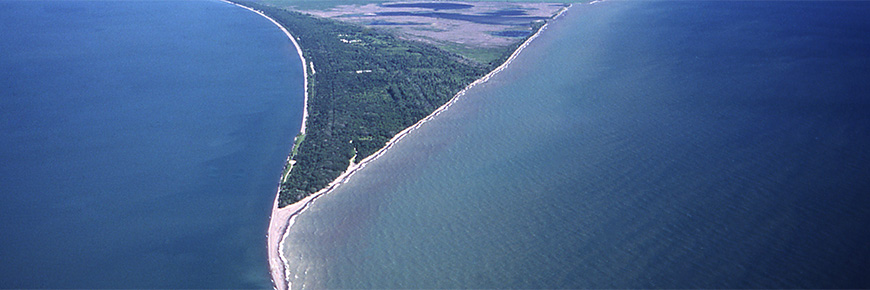
Climate
Point Pelee National Park
Carolinian Zone
Geography and the moderating effects of Lake Erie have allowed southern plants and animals to flourish at Point Pelee.
French explorers of what we today call Southwestern Ontario, reported this region's unusually small number of coniferous trees. Today's naturalists are more surprised by what is here rather than what is not. The vast forest of deciduous trees in which these early explorers found themselves, was in fact the northern end of a broad belt which extends from the coastal zone of the Carolinas, northward between the Mississippi River and the Appalachian Mountains, to southern Ontario.
Early scientists called this region the Carolinian zone. Now, it is more generally referred to as the eastern deciduous forest, except in Canada where the term Carolinian is still popular because of its southern flavour.
The plants and animals of Canada's Carolinian zone are found only in a narrow band. The northern boundary of this band follows the 8°C (46°F) isotherm (that is a line which defines an area in which the average daily temperature for the year is 8°C). Temperature, then, is a major factor in limiting the northward expansion of this unusual region.
Intrusion of the 8°C isotherm into Canada at this point is the result of two major factors. The first is geographical position. Southwestern Ontario extends south to the 42nd parallel, making it the southernmost tip of Canada. This contributes to its warmer climate, but "lake effect" is even more important.
Southwestern Ontario is almost completely surrounded by the Great Lakes. Large bodies of water like these are hard to heat and, once heated, are slow to cool. Consequently, they tend to cushion temperature peaks cutting off the high and low extremes. As a result, the Canadian Carolinian zone stays much warmer throughout the winter than a similar location such as Laramie, Wyoming, in the centre of the continent, even though they are at the same latitude.
Compared to the massive size of Canada, the Canadian Carolinian zone is very small. Altogether, it represents less than one-quarter of one percent of the total land mass of the country. Despite its small size, it is an area which is characterized by tremendous variety. Found here are more rare species of plants and animals than in any other region of Canada.
There are over 70 species of trees alone. Nowhere else in Canada are there more species of reptiles (27) and amphibians (20). The zone is also home to 50 species of spiders and insects not found elsewhere in Canada. Acadian flycatchers, Carolina wrens, blue-gray gnatcatchers, red-bellied woodpeckers, and yellow-breasted chats are at the northern limit of their breeding range. But many Canadians call the Carolinian zone home, too. As a result, much of the land has been cleared for cities and used as farm land.
In Essex County, about three percent of the total area remains wooded. The largest natural area in the county lies within the boundaries of Point Pelee National Park. Interwoven throughout the Park's 20-square-kilometre (8-square-mile) landscape is a patchwork of marsh, forest, fields, and beaches, producing a complexity of life that is unequalled, even in Canada's larger National Parks.
Related links
- Date modified :